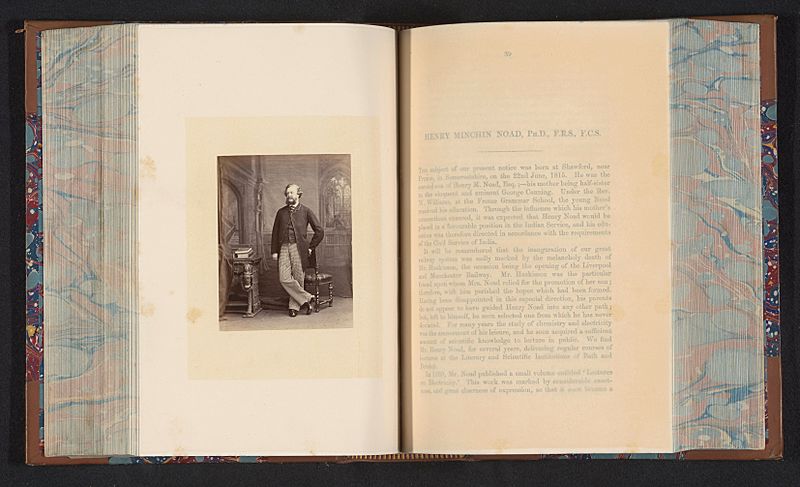Henry Minchin Noad facts for kids
Henry Minchin Noad (born June 22, 1815 – died July 23, 1877) was a famous British chemist and physicist. He was known for his work with electricity and for writing important science textbooks. He was also a Fellow of the Royal Society, which is a big honor for scientists.
Contents
Early Life and Education
Henry Minchin Noad was born in a place called Shawford, near Frome, in Somerset, England. This was on June 22, 1815. His father was Humphrey Noad. Henry went to the grammar school in Frome.
He first planned to work for the government in India. But a change in plans led him to study science instead. He became very interested in chemistry and electricity.
Becoming a Scientist
Around 1836, Henry Noad started giving lectures. He taught about chemistry and electricity in cities like Bath and Bristol. People learned a lot from his talks.
He then began to study how electricity worked with different metals. He looked at iron and bismuth. He also studied how a special type of battery, called a water battery, worked. Noad also helped explain why iron sometimes becomes "passive." This means it stops reacting to certain chemicals.
In 1845, he moved to London. There, he continued his chemistry studies at the new Royal College of Chemistry. While he was there, he researched different chemical compounds. He studied things like cymene, which is found in a plant oil. He also looked at other natural products like legumine and vitelline.
Teaching and Research
In 1847, Henry Noad became a professor of chemistry. He taught at the medical school of St George's Hospital. He stayed in this job for the rest of his life. Around 1849, he earned a special degree. He became a doctor of physics from a university in Germany.
In 1850 and 1851, he worked with another scientist, Henry Gray. They studied the spleen, which is an organ in the body. Their research was very good. It even won a special award called the Astley Cooper prize in 1852.
Noad also did many experiments on the chemistry of iron. In 1860, he wrote an important article about iron for a science dictionary. Because of his knowledge, he became an expert advisor for several big iron companies in South Wales. He helped them with their chemical processes.
Later, in 1866, he became an examiner for drinks at the India office. In 1872, he started examining students in chemistry and physics. This was at the Royal Military Academy in Woolwich. When the Panopticon of Science and Arts opened in London in 1854, he taught chemistry there. On June 5, 1856, he was chosen to be a Fellow of the Royal Society. This is a very high honor for scientists.
Important Books
Henry Noad was a member of the London Electrical Society. He wrote many important science books. In 1839, he published A Course of Eight Lectures on Electricity, Galvanism, Magnetism, and Electro-Magnetism. This book became a popular textbook. It was printed four times. Later, in 1857, he wrote A Manual of Electricity. This book had two volumes and was a standard book for a long time.
In 1848, he wrote a useful book about how to do chemical experiments and analysis. This was for a series called the Library of Useful Knowledge. In 1875, he updated another book called A Normandy's Commercial Handbook of Chemical Analysis. This book helped scientists who needed to check chemicals for quality.
Later Life
Henry Minchin Noad passed away on July 23, 1877. He died at his son's home in Lower Norwood, Surrey. He was buried at West Norwood Cemetery. His wife, Charlotte Jane, died a few years later in 1882.


